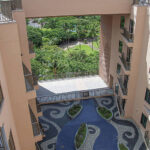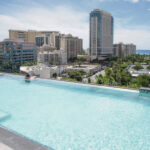Timeshare industry is growing in Hawaii




Timeshares in Hawaii are growing.
Marriott Vacations Worldwide just opened a timeshare resort in Waikiki, and Maui Bay Villas by Hilton Grand Vacation opened earlier this year, with more openings in the pipeline.
American Resort Development Association President and CEO Jason Gamel said Hawaii’s timeshare growth this year is significant given that in 2023 only five new timeshare resorts opened nationwide.
Gamel, who met with the Honolulu Star-Advertiser while in Hawaii to attend the Hawai‘i Tourism Authority Tourism Conference, said Hawaii has 99 timeshare resorts spread across 31 timeshare resorts on Maui, 27 on Kauai, 23 on Oahu, 17 on the Big Island and one on Molokai.
He said the unit count has grown to an estimated 14,000 and is evidence that demand for Hawaii timeshares is growing as well as interest in constructing them. That’s a rise of more than 34% from 2013 when there were 10,389 timeshare units in Hawaii, according to the state Department of Business, Economic Development and Tourism 2023 visitor plant inventory report.
While construction timelines for new timeshares in Hawaii were delayed by the COVID-19 pandemic, the unit count over the past few years has been accelerating. The current count is up more than 14% from 2023 when DBEDT data showed there were 12,231 units, and up 15.8% from 2019’s 12,090 timeshare units.
Gamel said the Marriott Vacation Club, Waikiki opened Oct. 4 with occupancy already above 90%. Betty Dela Cruz-Acob, director of rooms, operations, for the Marriott Vacation Club, Waikiki said the property was 100% occupied Monday for its grand-opening celebration.
The Marriott’s opening activates a section of Waikiki that hasn’t been able to realize its full potential since the closure of the former Niketown building, which left a prime parcel fronting Kalakaua and Kuhio avenues between Olohana and Kalaimoku streets empty for more than a decade.
Gamel said its urban setting also appeals to younger timeshare buyers, who are are looking for more active destinations. He said millennial and Gen Z timeshare buyers comprised 76% of recent timeshare purchasers versus 57% for all timeshare owners. He said the average age of a recent timeshare buyer is 36, compared with 45 for timeshare owners in general.
Dela Cruz-Acob said the Marriott Vacation Club, Waikiki is the first timeshare resort in Hawaii to open under the Marriott Vacation Clubs City Collection brand, which tends to appeal to active travelers, including younger travelers.
“The City Collection is all about connecting travelers to what the city has to offer, and we are even adding our own activities and programming,” Dela Cruz-Acob said.
The 110-unit property has a rooftop pool deck that boasts Waikiki’s highest infinity pool and the Malolo Bar, which serves a menu of elevated local favorites like poke nachos and loco moco with Wagyu beef, said Shary Takasane, Marriott Vacation Club, Waikiki’s director of food and beverage and activities.
Takasane said she is focusing on creating a “local insiders” program that connects guests to Hawaii’s food, culture and history, and is planning pop-ups that provide opportunities for local food and retail vendors.
“Our guests want to feel more like a kamaaina,” she said.
Gamel said timeshare owners tend to view themselves as stakeholders rather than visitors, and that’s part of the reason that timeshare occupancy in Hawaii has come back faster from the COVID-19 pandemic and from the Maui wildfires than hotels.
In 2023, timeshares made up 14.9% of lodging on Hawaii, according to DBEDT’s visitor plant inventory report, and timeshare visitors made up 9% of all Hawaii’s statewide visitor arrivals, up from 8.9% in the second quarter of 2023 and up from 8.6% in the second quarter of 2019.
“Hawaii (timeshares) still continued to be extremely high in demand despite overall headwinds — everything from recovery after the Maui wildfires to still recovering international travelers after COVID,” Gamel said.
Construction of the Maui Bay Villas by Hilton Grand Vacation, at 575 S. Kihei Road on a 27-acre site with oceanfront footage near Maalaea Bay, was delayed by COVID-19; however, the property held a formal grand opening in June.
Earlier this year construction restarted on the Ka Haku by Hilton Club, a 32-story, 205 unit-timeshare tower in the heart of Waikiki at the former King’s Village site. HGV demolished King’s Village in 2019 to make way for the new timeshare tower, which was anticipated to be completed toward the end of 2021. However, COVID-19 and the subsequent tourism downturn hit, causing a 3-1/2-year hiatus.
Gamel said Hawaii is expected to continue growing timeshare units and that a trend by large timeshare companies across the U.S. has been to add towers or units to existing properties.
He said the resilience of the timeshare market is evident in the sales volume data, which shows that during the height of the COVID-19 downturn in 2020, U.S. timeshares still generated $4.9 billion in sales. He said timeshare sales volume this year in the U.S. is already at an estimated $10.8 billion.
The estimated timeshare volume for Hawaii in 2023 was $860 million, Gamel said.
During the second quarter of 2024, DBEDT’s most recent timeshare performance data, some 211,646 visitors to the state chose to stay at a timeshare resort for all or part of their stay. That was a 4.5% decrease from the same quarter in 2023, and statewide timeshare arrivals trailed the second-quarter 2019 level by 5.8% However, Gamel said most of the decrease in timeshare visitor arrivals was driven by Maui County, which experienced an overall tourism slowdown following the August 2023 wildfires.
Statewide timeshare occupancy fell to 92.2% during the second quarter — a scant 0.3% drop from the 92.5% occupancy rate attained during the same period in 2023. The drop was due to Maui County’s post-fire decline as second-quarter timeshare occupancy rose in each of the other counties. In comparison, DBEDT reported that statewide hotel and condominium hotel occupancy averaged 73% during the second quarter, a decrease of 1.2 percentage points.
Statewide timeshare occupancy during the second quarter surpassed the 91.4% occupancy reached in the second quarter of pre-COVID-19 2019.
Gamel said the booking strength of Hawaii’s timeshares is an indication to ARDA that the industry has experienced some immunity from factors, such as rising travel costs and economic decline, which have contributed to the softening in the overall softening of U.S. visitor arrivals to Hawaii.
He said since timeshare owners already have paid for their accommodations, they are highly likely to use their scheduled vacation time in Hawaii. Gamel added that they also are likely to have more disposable income during their stay.





